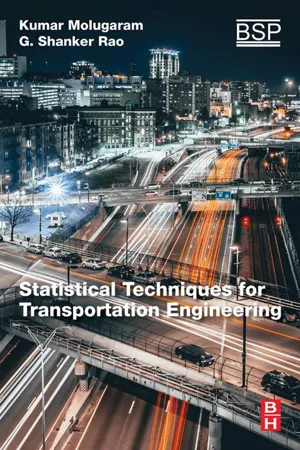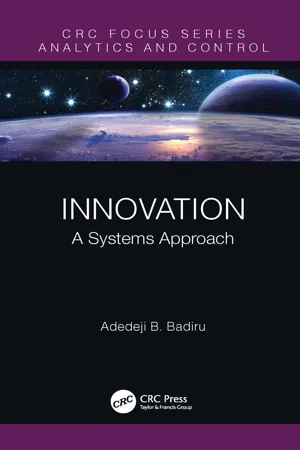Technology & Engineering
Engineering Statistics
Engineering statistics is the application of statistical methods to solve engineering problems. It involves the collection, analysis, interpretation, and presentation of data to make informed decisions in the design, development, and improvement of engineering systems and processes. The goal is to ensure that engineering products and services meet the required standards of quality, reliability, and safety.
Written by Perlego with AI-assistance
Related key terms
5 Key excerpts on "Engineering Statistics"
- eBook - ePub
- Alandra Kahl(Author)
- 2008(Publication Date)
- Bentham Science Publishers(Publisher)
Introduction to Statistics Alandra Kahl1 Department of Environmental Engineering, Penn State Greater Allegheny, PA 15132, USAAbstract
The field of statistics is vast and utilized by professionals in many disciplines. Statistics has a place in science, technology, engineering, medicine, psychology and many other fields. Results from statistical analysis underlying both scientific and heuristic reasoning, and therefore, it is important for everyone to grasp basic statistical methods and operations. A brief overview of common statistical methods and analytical techniques is provided herein to be used as a reference and reminder material for professionals in a broad array of disciplines.Keywords: Analysis, Heuristic reasoning, Scientific reasoning, Statistical methods.INTRODUCTION
The field of statistics deals with the collection, presentation, analysis and use of data to make decisions and solve problems. Statistics is important for decision-making, cost-benefit analysis and many other fields. A good grasp of statistics and statistical methods can be beneficial to both practicing engineering as well as practicing businessmen. Specifically, statistical techniques can be a powerful aid in designing new products and systems, improving existing designs and developing and improving production processes. Statistical methods are used to help decide and understand variability. Any phenomenon or operation which does not produce the same result every time experiences variability. Individuals encounter variability in their everyday lives, and statistical thinking and methods can be a valuable aid to interpret and utilize variability for human benefit. For example, consider the gas mileage of the average consumer vehicle. Drivers encounter variability in their gas mileage driven by the routes they take, the type of gas they put in their gas tanks, and the performance of the car itself as examples. There are many more areas in which variability is introduced, all of which drive variability related to the gas mileage of the individuals’ car. Each of these are examples of potential sources of variability in the system of the car. Statistics gives us a framework for describing this variability as well as for learning which potential sources of variability are the most important or have the greatest impacts on performance. Statistics are numerical facts or figures that are observed or obtained from experimental data. - Kumar Molugaram, G Shanker Rao(Authors)
- 2017(Publication Date)
- Butterworth-Heinemann(Publisher)
Chapter 1An Overview of Statistical Applications
Abstract
This chapter introduces an overview of statistical applications to transportation engineering. It gives an introductory idea on various aspects of statistics such as discrete and continuous functions, distributions describing randomness, and data organization. It also covers some of the aspects under common statistical estimators such as measure of central tendency, measure of dispersion. Further it gives an insight application of normal distribution, confidence bounds, sample size determinations, random variable summation, binomial distribution, Poisson distribution, testing of hypothesis, and other aspects. This chapter covers various aspects of statistical techniques most frequently employed by transportation engineers.Keywords
Discrete functions; measure of central tendency; measure of dispersion; normal distribution; confidence bounds; sample size determination; central limit theorem; binomial distributions and testing of hypothesis1.1 Introduction
Civil engineering is considered to be one of the oldest engineering disciplines. It deals with planning, analysis, design, construction, and maintenance of the physical and naturally built environment. The subject is grouped into several specialty areas namely, Structural Engineering, Construction Engineering and Management, Transportation Engineering, Water Resource Engineering, Surveying, Environmental Engineering, and Geotechnical Engineering. Transportation engineering involves the collection of huge amount of data for performing all types of traffic and transportation studies. The analysis is carried out based on the collected and observed data. The statistical aspects are also an important element in transportation engineering specifically traffic engineering. Statistics facilitates to resolve how much data will be obligatory, as well as what consequential inferences can confidently be finished based on that observed and collected data. Generally statistics is required whenever it is not possible to directly measure all of the values required. If the traffic engineer needs to know the average speed of all vehicles on a particular section of roadway, not all vehicles could be observed. Even if all speeds of vehicles could be measured over a specified time period, speeds of vehicles arriving before or after the study period or on a different day then the sample day would be unknown. In effect, no matter how many speeds are measured, there are always more that are not known. For all practical and statistical purposes, the number of vehicles using a particular section of roadway over time is infinite. Therefore the traffic engineering often observes and measures the characteristics of a finite sample of vehicles in a population that is effectively infinite. The mathematics of statistics is used to estimate characteristics that cannot be established with absolute certainty and to assess the degree of certainty that exists.- eBook - ePub
- Farouk A.M. Rizk, Giao N. Trinh(Authors)
- 2018(Publication Date)
- CRC Press(Publisher)
3 Application of Statistical Analysis in High Voltage Engineering 3.1 IntroductionHigh voltage engineering relies heavily on experimental data. However, experiments are often costly and time consuming, and in this context, analysis of experimental data has always been of great importance to extract proper information. Because statistical analysis is independent of the phenomenon or objects under investigation, it is applicable to a variety of subjects to sort out their representative parameters and to derive models that help make predictions about their performance under different conditions. It is no surprise therefore, that statistical analysis has found its way into high voltage engineering as a means to plan testing and analyze experimental data (Hauschild and Mosch, 1992).However, precisely because it is phenomenon-independent, statistical analysis alone cannot provide a physical explanation on the phenomena under study. It can only present a better, more coherent picture of the set of available data, as well as provide some insight into the phenomenon investigated. Best results are obtained when statistical analysis is paired with an understanding of the physics involved.Statistical applications to engineering studies are numerous. In the field of high voltage engineering, it has been used to - eBook - ePub
Innovation
A Systems Approach
- Adedeji B. Badiru(Author)
- 2020(Publication Date)
- CRC Press(Publisher)
7Innovation, Quality Engineering, and Statistics
Adapted and reprinted by copyright permission from:Introduction
George E. P. Box & William H. Woodall (2012) Innovation, Quality Engineering, and Statistics, Quality Engineering , 24:1, 20–29, DOI: 10.1080/08982112.2012.627003 (a Taylor & Francis Group publication)This chapter is an adaptation of the 2012 journal publication by Box and Woodall (2012), in which a linkage was made between innovation, quality engineering, and statistics. The contents of the original paper bear out the benefit of approaching innovation from a diverse systems viewpoint. The chapter has historical significance because, as long ago as 2012, the interest in the ramifications of innovation was already being pitched. This shows that the present wave of innovation is not totally new. Like all cycles of hype, innovation is here now. It may subside over time, but it will rise again in the future.The chapter highlights the roles of statistics and quality engineering in the innovation process in business and industry. We review approaches that can be used in order to increase the chances of innovative discoveries. Most importantly, we stress the necessity for the quality engineering community to strengthen and promote its role in innovation. As Bisgaard (2006) has said, we should reframe much of what we do as systematic innovation. Adapting to the changing business and economic climate can revitalize our profession; failure to adapt threatens it.There has been much discussion in the business literature on the importance of innovation and how businesses can best manage innovation. Thus, Michael E. Porter, Harvard Business School professor and leading management expert, has pointed out, “Innovation is the central issue in economic prosperity.” As Porter and Stern (2001, p. 2) said, the way companies can gain a business advantage today is “to create and commercialize new products and processes, shifting the technology frontier as fast as their rivals can catch up.” - eBook - ePub
- John K. Taylor(Author)
- 2018(Publication Date)
- Routledge(Publisher)
CHAPTER 4Statistical TechniquesEvery practicing analytical chemist must have a good understanding of the statistics of measurement. Statistical principles are applied when demonstrating statistical control, evaluating data, designing measurement and sampling plans, and making a wide variety of decisions in the use and application of measurements. Fortunately, modern calculators, computers, and data processing systems have built-in statistical packages that lessen the labor of statistical application, but they do not eliminate the requirement for understanding. In fact, the improper use of statistics and their inappropriate application can be as hazardous as using faulty data to make decisions.This chapter is included to review the basic concepts of the statistics of measurements and to provide guidance in their application. Because of the small amount of data that ordinarily is available, statistical judgments should not be followed blindly. Whenever there is conflict between an intuitive and a statistically-based conclusion, the basis for both conclusions should be reviewed. Perhaps something has been overlooked in the reasoning process, or the statistical model may be faulty. Perhaps more data may be needed to strengthen the statistically-based decision. Reconciliation of any differences could lead to a better understanding of the measurement process and improvement of the present as well as future sets of data.
Index pages curate the most relevant extracts from our library of academic textbooks. They’ve been created using an in-house natural language model (NLM), each adding context and meaning to key research topics.




